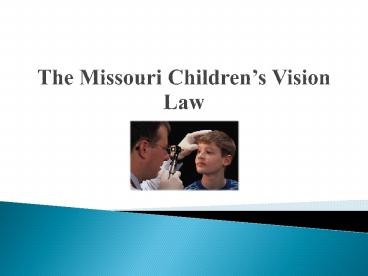The Missouri Children - PowerPoint PPT Presentation
1 / 20
Title:
The Missouri Children
Description:
Strabismus (eye turn) Focusing problems. Accommodation. Convergence. Blur at distance ... myopia, hyperopia, astigmatism, amblyopia, strabismus and focusing disorders ... – PowerPoint PPT presentation
Number of Views:148
Avg rating:3.0/5.0
Title: The Missouri Children
1
The Missouri Childrens Vision Law
2
- 1. Common vision disorders in children
- 2. Purpose for the law
- 3. History of the law
- 4. Details
- 5. Childrens Vision Commission
- 6. Difference between exams screenings
- 7. Financial questions
- 8. Resources for help
3
Common Vision Disorders
- Myopia (nearsighted)
- Hyperopia (farsighted)
- Astigmatism (oval shaped cornea)
- Amblyopia (lazy eye)
- Strabismus (eye turn)
- Focusing problems
- Accommodation
- Convergence
4
Myopia (nearsightedness)
- Blur at distance
- Trouble seeing the chalkboard
- Light focuses before it reaches the retina
- Causes
- Eye too long
- Cornea too curved
- Corrected by
- Eyeglasses
- Contacts
5
Hyperopia (farsighted)
- Blur at near
- Trouble seeing books
- Light focuses after reaching the retina
- Causes
- Eye too short
- Cornea too flat
- Corrected by
- Eyeglasses
- Contacts
6
Astigmatism
- Blur distance and near
- Caused by irregular shaped cornea
- Corrected by
- Eyeglasses
- Contacts
7
Amblyopia
- Blur at distance and near even with correction
- Causes
- Developmental
- Refractive
- Eye turn
- Treatments
- Patching
- Atropine drops
- Glasses, contacts
- Vision therapy
8
Focusing Problems
- Typically affect reading only
- Focusing muscles not working properly
- Accommodation
- Convergence
- Corrected by
- Eyeglasses?
- Vision Therapy?
9
Strabismus
- May cause double vision
- Poor depth perception
- Distance
- Near
- Causes
- Muscle imbalance
- Hyperopia
- Corrected by
- Eyeglasses, contacts if refractive
- Surgery may be necessary
- Vision Therapy may be necessary
10
Purpose for the Law
- 80 of learning comes through vision
- Vision disorders rank as the most prevalent
handicapping condition in childhood. - 5 of children are identified as having vision
problems during a typical vision screening. - Yet, 10-12 of preschoolers have vision
deficiencies - 6 of children who fail a school screening will
not receive a comprehensive exam - Only 15 of children under the age of five have
received a comprehensive eye examination. - 60 of children with learning disabilities also
have undetected vision disorders
National Eye Institute
11
History of the Law
- Original bill was sponsored by Speaker of the
House Rod Jetton. - Speaker Jettons son had a vision disorder that
wasnt diagnosed until he had an eye examination
by Dr. Steve Tilley. - The bill that passed this year was sponsored by
Rep. David Pearce in the house and by Sen.
Delbert Scott in the senate.
12
Law Details
- Beginning July 1, 2008 all children entering
kindergarten or first grade are required to have
a comprehensive eye examination. Evidence of the
exam shall be submitted to the school no later
than January1, of the school year. - The law sunsets in 2012, when it will be
re-evaluated by the Childrens Vision Commission
and the Missouri legislature. - Parents may opt out of the examination with
written notice to the school district. - There are no penalties associated with the law.
13
Childrens Vision Commission
- Two optometrists
- Two ophthalmologists
- One school nurse
- One Rep. from Dept. of Elementary and Secondary
Education - One Rep. from Missouri School Board Association
14
Childrens Vision Commission
- Establish statewide guidelines for exams and
reporting process - Monitor exam results and make recommendation to
state legislature on whether to continue law at
its sunset.
15
Whats the Difference Between an Eye Examination
and a Vision Screening?
16
Vision Screenings
- Often performed by pediatrician, school nurse or
volunteer - May detect myopia, hyperopia, color or depth
perception problems - Amblyopia screenings?
- Not comprehensive but very valuable
17
Comprehensive Eye Examination
- Performed by optometrist or ophthalmologist
- Can detect and treat myopia, hyperopia,
astigmatism, amblyopia, strabismus and focusing
disorders
18
Whos going to pay for the exams?
- Estimated that 70 of these children already have
insurance coverage for comprehensive eye exams. - Parents responsibility
- Blindness Education Fund
- Charitable organizations, ie. Vision Service
Plan, Cerner First Hand Foundation. - Donations by the doctors.
19
Its ALL About our Children!
- Every single child in Missouri deserves to
opportunity to reach their full potential as a
student. - Educators have been mandated with No Child Left
Behind - 80 of learning during a childs early school
years is through vision. - Without at least one comprehensive eye exam, some
of our children will continue to slip through
the cracks.
20
Resources
- Missouri Optometric Association
- www.moeyecare.org































